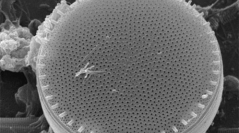

 Cryptogamie, Algologie
28 (3) - Pages 245-269
Cryptogamie, Algologie
28 (3) - Pages 245-269With regard to pelagic algae, Lake Kivu is the least known among the East- African Great Lakes. The data available on its phytoplanktic communities are limited, dispersed or outdated. This study presents floristic data obtained from the first long term monitoring survey ever made in Lake Kivu (over two and a half years). Samples were collected twice a month from the southern basin, and twice a year (once in each season) from the northern, eastern and western basins. In open lake habitats, the four basins presented similar species composition. The most common species were the pennate diatoms Nitzschia bacata Hust. and Fragilaria danica (Kütz.) Lange-Bert., and the cyanobacteria Planktolyngbya limnetica Lemm. and Synechococcus sp. The centric diatom Urosolenia sp. and the cyanobacterium Microcystis sp. were also very abundant, mostly near the surface under daily stratification conditions. Some typical low epilimnion/metalimnion species were Cryptaulax sp., Cryptomonas sp., Rhodomonas sp. and Merismopedia trolleri Bach. Vertical stratification appeared to be the most important factor of diversification. Limited changes were apparent in comparison with the situation described in 1937 after the first Belgian expeditions. No evidence of an effect of the planktivorous sardine Limnothrissa miodon Boulenger (introduced from Lake Tanganyika) on phytoplankton diversity is available.